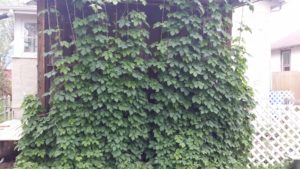When my 24th birthday was coming up, my wife asked me what I wanted for my birthday.
“A house!” I blurted out.
She blinked a couple of times and said “Well, okay.”
The hunt began. We’d been living in an apartment for two years and while I didn’t mind it over all, I was really wanting to stretch out and have room to do STUFF.
I grew up on 80 acres, a mix of pasture and woods with a spring and pond. Most of my childhood was spent outside and by my mid 20s my need to be playing in the soil was returning.

We had to make some compromises though. At that time, property was expensive and we didn’t have much time or expertise to take on a fixer upper project. We also wanted to keep close to our respective jobs. Most of our search was within city limits and within 8 weeks, we had found a 1899 Craftsman home that had been renovated and updated and was within our budget. It sat on a ⅕ acre lot that was level and rectangular.
We moved in during the Spring of 2007.
As we began to settle in, I started making plans for the property. I knew I wanted to grow food and eventually add some chickens. Because space was limited, I performed several seasons of trial and error in terms of growing. At times I grew frustrated because my conventionally minded brain was convinced that I needed large, sweeping spaces to cultivate in order to have any kind of large yields. Then I ran across the concept of permaculture and intensive gardening. I began to see the potential in every space, horizontally and vertically. I figured out what could be grown and maintained in planters, what would thrive in simple hydroponic systems or how to best utilize edge space.
I began to understand the importance of careful assessment and observation of a parcel to see what it may be best suited for.
A lot of us skip over that step. I know I did. When I put in my first garden beds, I parked them too far from the house, in too much shade and in a place that pools with water when we have heavy, persistent rain. Pretty much the worst location I could find. Now the main garden is directly off the back porch and wraps around the deck. I walk past it anytime I go out the back door so it’s easy to keep it maintained. It receives plenty of sun and is close to the rain barrels. I’ve been able to build up the soil so it drains well even in heavy rain.
I still do some experiments from time to time and make notes on how to improve on the next round. When I’m pushing the envelope, that’s just part of the process.
Right now I’m interested in utilizing rooftop space for a green roof design that will hopefully keep an area of the house cooler in the summer. It’s a nearly flat roof with no attic space that receives sun from around 10 am to 7 pm. It really roasts in there and continues to heat the adjacent kitchen and bedroom. The roof itself needs some repair from a persistent leak so when I get up there to make the repairs, I’ll be working with those changes in mind.
When it comes to adding new beds or other infrastructure around the home place, my mind is always working in the background. So far we have multiple raised beds, each one suited to a different microclimate. For instance, the beds positioned on the west side of the yard that are almost always shaded as they sit between my house and my neighbor are well suited to salad greens when other parts of the yard would be too hot.
We also built hugelkulture mounds along the roadside on the northern edge of the property. This site gets nearly full sun and the mounds, made from logs and leaf clippings, provide a rich, well drained place for an edge of wildflowers that the bees and butterflies visit regularly. The mounds also act of a means of slowing and spreading water run off from the road.

These are just a few examples of the improvements we have made.
The point to all of this is that there’s almost always ways to work around limitations and one of the abilities I’ve cultivated over the years is to see the potential of a variety of properties. When I’m visiting someone, my mind is always working in the background, thinking “man’s that’s a good spot for a permanent asparagus bed.” Or “That west wall gets so much sun that with a little soil work, hops would make a really neat shade cover.”
Keep in mind: Cultivate the potential. Embrace the learning curve.
The journey really is the best part.
